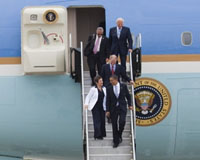 |
Yuma AZ (SPX) Apr 19, 2010 Under a brilliant early morning Arizona sky, NASA conducted a successful, record-breaking test of a drogue parachute being designed to return next-generation space vehicles safely to Earth. The 77,000-pound payload used in the test was dropped from the back of a U.S. Air Force C-17 at an altitude of 25,000 feet, setting a record for the heaviest single load ever extracted out of a C-17 during flight. NASA conducted the drop test, April 14, at the U.S. Army's Yuma Proving Ground near Yuma, Ariz. The design load limit test will provide engineers with a better understanding of the full structural capabilities of the drogue parachute, currently under development for the Ares launch vehicles. The 68-foot-diameter drogue and all test hardware functioned properly and landed safely. "Testing of a deceleration system is a very complicated process," said Ron King, Ares I first stage deceleration subsystem manager for the Ares Projects at the Marshall Space Flight Center in Huntsville, Ala. "All elements must work together in a carefully timed sequence to ensure a successful test. Through continued development and fine-tuning of the recovery system, our team is establishing a solid foundation for safe, reliable payload recovery." The test team is managed by the Marshall Center and included engineers with ATK Space Systems near Promontory, Utah, the prime contractor for the first stage booster and United Space Alliance - ATK's subcontractor, responsible for design, development and testing of the parachutes at its facilities at NASA's Kennedy Space Center, Fla. This was the second in a series of three planned load limit tests designed to place the loads expected in flight on the parachute canopy. The next test series, called overload tests, will subject the parachute canopy to loads greater than what would typically be experienced in flight, to prove the parachute is strong enough to survive some degree of unexpected events. A load limit test, as the name implies, pushes the parachute's canopy to its designed limit - supporting a 450,000-pound opening dynamic load, or force in pounds exerted on the parachute generated by the drag and pull of the parachute when it opens. The primary test objective was to deploy or open the parachute at a dynamic pressure of 420 pounds per square foot, simulating the opening load conditions the drogue parachute will experience when it is deployed to slow the rapid descent of the rocket's spent first-stage motor. The complete motor recovery system consists of the pilot parachute, drogue parachute and three main parachutes. Similar to those used for the space shuttle boosters, these parachutes have been redesigned to accommodate larger, more powerful motors that will travel faster and fall from a higher altitude than the shuttle boosters. The drogue parachute is the workhorse of the parachute recovery system, providing the initial deceleration and taking the brunt of impact as it slows the rapid descent of the rocket's spent first-stage motor. As the test series progresses, engineers perform three classifications of testing: development, design load and overload. Each level of testing is intended to test the performance of the new parachute design with payloads of different size and weight, under varying conditions. The U.S. Army's Yuma Proving Ground provides the test range, support facilities and equipment to NASA for parachute testing. The U.S. Air Force Flight Test Center at Edwards Air Force Base, Calif., provided the C-17 test aircraft and crew.
Share This Article With Planet Earth
Related Links - Space Tourism, Space Transport and Space Exploration News
 Obama aims to send astronauts to Mars orbit in 2030s
Obama aims to send astronauts to Mars orbit in 2030sKennedy Space Center, Florida (AFP) April 15, 2010 US President Barack Obama said Thursday he is aiming to send US astronauts into Mars orbit in the mid-2030s as he sought to quell protests over his earlier space policies. "By 2025 we expect new spacecraft designed for long journeys to allow us to begin the first ever crew missions beyond the moon into deep space," Obama told an audience at the Kennedy Space Center in Florida. "So, we'll ... read more |
|
| The content herein, unless otherwise known to be public domain, are Copyright 1995-2010 - SpaceDaily. AFP and UPI Wire Stories are copyright Agence France-Presse and United Press International. ESA Portal Reports are copyright European Space Agency. All NASA sourced material is public domain. Additional copyrights may apply in whole or part to other bona fide parties. Advertising does not imply endorsement,agreement or approval of any opinions, statements or information provided by SpaceDaily on any Web page published or hosted by SpaceDaily. Privacy Statement |